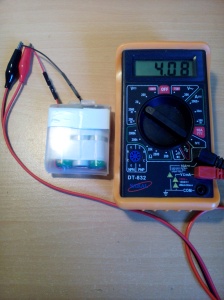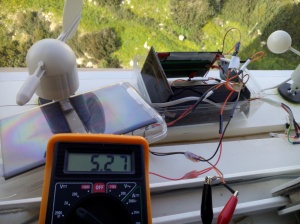Today’s experiment goals:
– to check if smaller 3×1.2V (3x3Ah) Ni-ME battery array will charge better than 4×1.2V (4x3Ah) and if it will be enough to keep the anemometer alive
– to make order in the wires
– to recheck voltages given by the solar panels
Related experiments:
- Raspberry-pi: experiment 13. Wind speed and direction meter (anemometer)
- Raspberry-pi: Experiment 13. Anemometer based on sensors f200-2012
- Raspberry-pi: Experiment 13. Thermal sensor and more
- Raspberry-pi: Experiment 13. Anemometer. Less power consumed more produced and preserved
Conclusions:
– the small battery pack turned as insufficient for keeping the device alive even for few minutes
– the device was assembled with old battery pack of 4×1.8Ah Li batteries which was enough for 2 days of operation in the past
– the research on how to keep the device longer on solar energy will be continued
The report:
– 3×1.2V battery pack was built



– Other batteries also were fixed and recharged to be ready for the device assembling in case the small battery will be not sufficient
– order was made in the wires to make the maintenance easier and to ensure components don’t disconnect during assembling
– Voltages given by each panel and the whole solar array were measured










Pingback: Raspberry Pi Experiment 13: Wind Speed and Direction Meter (Anemometer) | My Hobby of 'Making'
Pingback: Raspberry Pi Experiment 13: Anemometer based on sensors F200-201/2 (wind speed/direction) | My Hobby of 'Making'
Pingback: Raspberry Pi Experiment 13: Anemometer. Less power consumed more produced and preserved | My Hobby of 'Making'
Pingback: Raspberry Pi Experiment 13: Thermal sensor and more | My Hobby of 'Making'
Pingback: RASPBERRY PI EXPERIMENT 13: Anemometer based on sensors F200-201/2 v2 | My Hobby of 'Making'